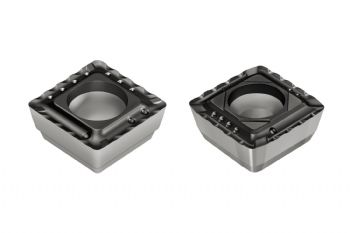
The Tiger.tec Silver range of indexable turning inserts — available from Walter GB Ltd, Bromsgrove (
www.walter-tools.com) — has been extended with a new trio of positive styles for small-diameter ISO P steel applications at low cutting pressures.
Geometries FP4 (for controlled chip-breaking when finishing), MP4 (of universal design and for mid-range machining of particularly long-chipping materials) and RP4 (for roughing) are now available in WPP10S, WPP20S and WPP30S Tiger.tec Silver grades.
Also designed for controlled chip-breaking, the MP4 geometry is available with two clearance angles (7deg and 11deg), as well as in precision-sintered and precision-ground designs. The clearance angle of 11deg is particularly suitable for machining smaller diameters, while precision grinding provides an indexing accuracy of ±25µm; this is twice as accurate as sintering and is ideal for precision finishing.
With positive inserts featuring two to four cutting edges, compared to negative inserts with double the number of cutting edges, users may assume that the positive insert is less
economical. However, the positive shape offers lower cutting pressures and a softer cutting action, making it suitable for machining smaller diameters or very long unstable components and economic for these applications.
On multi-spindle machines, users can use higher feed rates while achieving excellent chip control.
During field testing, an MP4/WPP10S insert was able to machine 60 components compared to 35 with a competing product — and only one dimensional correction was required, instead of the usual five.
Moreover, the cutting-tool material, radius and geometry information is laser-marked onto each individual insert, helping to minimise the chance of inserts being mixed up.